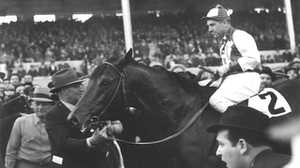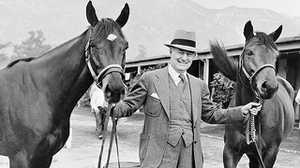Horseracing in the U.S.

1750: Early History
American horse breeders and racers establish the Jockey Club. Today, the club still defines standards and regulations for racing, racecourses and breeding.
1798
English racing legend Diomed is imported to Virginia. Having failed as a stud in England, and with his best days thought to be behind him, the 21-year-old stallion adapts happily to American life, siring so many children that he will be considered the father of American Thoroughbreds.
May 27, 1823
Thoroughbreds American Eclipse and Sir Henry meet in three four-mile races at Union Race Course for a first North versus South match-up. The Northern contender, Eclipse, wins. A North-South horse racing rivalry will continue up until the Civil War.
1840
Westward-moving settlers take horse racing with them, establishing the sport in Illinois, Missouri, Texas, and Louisiana.
1850s
Prospectors heading to the Gold rush bring Thoroughbreds to California.
1861
Thoroughbred racing suffers a huge setback during the Civil War. The breeding centers of Virginia and the Carolinas are destroyed. Thoroughbreds are pushed into military service.
August 3, 1863
A new racetrack opens in Saratoga, New York. The state is on its way to becoming the center of American racing.
June 19, 1867: American Racetracks
The first Belmont Stakes is run at Jerome Park. The race will later move to Belmont Park and become the third and final jewel in the Triple Crown.
May 27, 1873
The first Preakness Stakes, which will become the second race of the Triple Crown, is run at Pimlico Course in Maryland.
May 27, 1875
The Kentucky Derby is first run at the Louisville Jockey Club Course, later known as Churchill Downs. It will become the first trophy in the Triple Crown.
1900
Horse racing fans can bet at over 300 racetracks across the country, but members of the rising progressive movement include gambling among the social ills they campaign to reform.
1903
Charles Howard who will later own seabiscuit, arrives in San Francisco, California, with 21 cents to his name. In 1905 he will open a California Buick dealership with three cars.
April 18, 1906
The San Francisco earthquake and subsequent fires destroy everything in a 4.7-square-mile area, including 28,000 buildings. Charles Howard uses automobiles from his Buick showroom as rescue vehicles when horses are injured or refuse to go down burning streets.
February 5, 1909
Gambling corruption at racetracks leads the California state legislature to ban betting on horses. New York State soon follows.
May 31, 1910
George Woolf, who will ride Seabiscuit in the great match race with War Animal, is born.
November 1, 1910
Red Pollard, Seabiscuit’s jockey, is born.
May 8, 1915
A filly named Regret wins the Kentucky Derby, running against a field of colts.
1919: Horse Racing Takes Off
After World War I, horse racing booms. Tracks are now free from the problems of wartime rationing and limited transportation. Increased use of the pari-mutuel system is slowly helping to make betting on horses legal again. More racetracks open.
June 11, 1919
Sir Barton becomes the first horse to win all three of the most important stakes races for three-year-olds: the Kentucky Derby, the Preakness Stakes, and the Belmont Stakes. This series of races will later be known as the Triple Crown.
October 29, 1929
The U.S. stock market crashes, triggering the Great Depression, the worst economic collapse in the history of the modern industrial world.
1930
A sportswriter coins the term “Triple Crown” when Gallant Fox wins the Kentucky Derby, the Preakness Stakes, and the Belmont Stakes.
1932
Now wealthy from selling automobiles, Charles Howard marries for a second time. Marcela Zabala is the older sister of his son’s wife. The couple shares a passion for horse racing.
March 4, 1933
In his inaugural address President Franklin Delano Roosevelt tells Americans, “the only thing we have to fear is fear itself…” A week later, nearly 60 million people sit by their radios to listen to Roosevelt’s first “fireside chat.”
March 13, 1933
Racetrack betting is legalized again in California. Over the next six years, betting on horses will become legal again in 21 states, as Depression-era governments struggle to find revenue. Times are tough: one in four Americans is unemployed, and the average annual salary for those working is $1,367.
May 23, 1934: Seabiscuit
Seabiscuit is born. He is the descendant of the great Thoroughbred Man o' War, through his son Hard Tack.
Fall, 1934
James 'Sunny Jim’ Fitzsimmons, a successful thoroughbred conditioner and Seabiscuit’s first trainer, notes Seabiscuit’s speed in workouts. Fitzsimmons uses the whip on Seabiscuit to break the horse’s lazy habits.
Tom Smith seeks work at Agua Caliente in Tijuana, Mexico. There he meets Charles Howard, who hires him as his horse trainer.
June 11, 1935
Two-year-old Seabiscuit loses his seventeenth consecutive race. Though he is racing in poor company, he has yet to win a single race.
June 29: 1936
Tom Smith and Seabiscuit meet at Suffolk Downs outside Boston, Massachusetts. They look at each other and nod. Recognizing something special about the horse, Smith leans over the rail and whispers to Seabiscuit, “I’ll see you again.”
August 3
Charles and Marcela Howard see Seabiscuit win a race at Saratoga. Tom Smith looks the horse over and tells Howard to buy Seabiscuit.
August 16
Red Pollard, traveling around looking for work as a jockey, walks into the Detroit Race Track, where he meets Tom Smith and Seabiscuit. Smith sees that Pollard and Seabiscuit are compatible.
September 7
Seabiscuit achieves his first big win in the Governor’s Handicap, winning over half his purchase price. It is the fiftieth race of his career, and the first in which he displays a new-found inclination for racing.
October 24
Long-shot Seabiscuit wins the Scarsdale Handicap, a mid-level stakes race. The fierce contest is won by mere inches in a photo finish.
Fall
Baseball dominates the sports news. In his rookie season, Joe DiMaggio takes the New York Yankees to the World Series. He hits a scorching .346 in his first World Series against the Giants and the Yankees are again baseball champions, the first time since 1932.
President Franklin Roosevelt receives a second overwhelming mandate at the polls with 61% of the popular vote.
November 28
Seabiscuit wins the Bay Bridge Handicap by five lengths, clocking the fifth fastest mile on record at the time.
December 12
Seabiscuit wins the World’s Fair Handicap easily. He comes down the stretch alone, to wild cheers and Pollard’s futile attempts to slow his speed. Four days later he will arrive in Santa Anita and be welcomed by a skeptical press corps.
Winter: 1937
A few bad breaks prevent Seabiscuit from racing and cultivate his laziness and love of food — setting him back in his conditioning for the Santa Anita Handicap, a race with an unheard-of $100,000 purse.
February 27
In his first try at the Santa Anita Handicap, Seabiscuit loses to Rosemont by a nose in a photo finish.
March 6
Seabiscuit draws a crowd of 45,000 excited fans and wins the San Juan Capistrano Handicap by seven lengths, smashing the track record.
May 6
The German airship Hindenburg bursts into flames as it is about to land in Lakehurst, New Jersey. A reporter on the scene describes the horrific event to a live radio audience.
May 29
A week after winning the Bay Meadows Handicap, Seabiscuit heads to the East Coast, to prove himself in the home of racing's prestige.
June 5
War Admiral captures the Triple Crown after a win at the Belmont Stakes despite stumbling at the start and injuring his right foreleg.
June 26
Seabiscuit runs in the Brooklyn Handicap, beating rival Rosemont and local horse Aneroid. Eastern writers who had previously called him “Glorified Plater” are now reluctantly quieted.
In July he will win the Butler Handicap and the Yonkers Handicap easily, despite carrying far more weight than his competitors in both races.
October 12
Seabiscuit wins the Continental Handicap in New York, gaining the top spot in the 1937 winnings race with $152,780 earned, $8,000 ahead of War Admiral.
November 6
After being scratched from two races in the previous week due to muddy track conditions, Seabiscuit easily wins the Riggs Handicap after rival War Admiral is scratched. Seabiscuit breaks the track record while carrying a startling 130 pounds. With the win, Seabiscuit now moves past War Admiral in earnings by $9,000.
Mid-November
Seabiscuit begins the train journey back to California, stopping along the way to appear for his adoring fans.
December 7
Following a near-collision with another horse and rider at Tanforan Race Track in California, Pollard is suspended from racing at Tanforan for the remainder of 1937. In the wake of the devastating suspension, War Admiral is named horse of the year by Turf and Sport Digest.
Two weeks later Pollard will be suspended by the California Horse Racing Commission from riding on any California track until January 1, 1938. Furious at the harsh judgment, Howard pulls Seabiscuit out of races until Pollard’s suspension is over.
January: 1938
Howard scratches Seabiscuit from the New Year’s Handicap and the San Pasqual Handicap after the horse is assigned a heavy impost of 132 pounds for both races.
February 1
California police uncover a plot to harm Seabiscuit by placing a sponge up his nose to obstruct his breathing. The “sponging” accusation is front-page news.
February 19
Smith scratches Seabiscuit from his fourth straight race, the San Carlos Handicap, because of rain the night before. Pollard makes the fateful choice to ride Fair Knightess, and the horse falls, crushing the left side of Pollard’s chest.
March 5
In Seabiscuit’s second appearance at the Santa Anita hundred-grander, George Woolf rides the bay colt as Pollard, recuperating from his fall, watches from the stands. Trapped at the start by Count Atlas, Seabiscuit loses to Stagehand in a photo finish. Despite the loss, many consider Seabiscuit’s performance the greatest in racing history and attribute his loss only to the weight system and a foul by another horse.
March 27
Seabiscuit makes a celebrity entrance in Tijuana for the Agua Caliente Handicap. Americans flood the border and overwhelm Tijuana, hoping to watch the race. Seabiscuit wins easily.
April 13
Howard and War Admiral’s owner, Samuel Riddle, agree on terms for a match race between Seabiscuit and War Admiral. The race is set for May 30 at Belmont, War Admiral’s home track. Howard lures Riddle into the agreement with favorable conditions for War Admiral and a $100,000 purse.
April 16
Seabiscuit cruises to a new track record in the Bay Meadows Handicap despite carrying 133 pounds, the highest weight assigned to a horse in modern California racing.
May 20
Seabiscuit and War Admiral pose for a photo session as New York publicity reaches a frenzy.
May 24
Howard scratches Seabiscuit from the match race at Belmont following several days of slow workouts, and rumors of a possible injury.
June 4
Seabiscuit places second in the Stars and Stripes Handicap, leading spectators to believe that his best days are behind him. Following the race, Seabiscuit heads home to California.
June 23
Pollard agrees to work a friend’s colt, Modern Youth. The horse, spooked, leaves the track at breakneck speed and crashes into a barn. Pollard’s leg is crushed.
June 29
Smith scratches Seabiscuit from the Massachusetts Handicap at the last minute upon discovering the horse has a leg injury.
July 16
Seabiscuit beats Specify and wins the Hollywood Gold Cup, breaking a track record and reestablishing his prominence. george Woolf brings Seabiscuit from 14 lengths behind to win the race.
On August 12, Seabiscuit will beat Ligaroti, a horse co-owned by Bing Crosby and Howard’s son Lin, in a match race at Del Mar.
October 5
The rescheduled match between Seabiscuit and War Admiral is announced for November 1. The horses will meet at Pimlico in Maryland.
October 30
Orson Welles’ radio broadcast of War of the Worlds, the tale of a Martian invasion on Earth, creates panic among listeners who mistake it for news.
November 1
The long-anticipated match race is run. With 40 million listeners tuned in across the country, Seabiscuit beats War Admiral by four lengths in just over a minute fifty-six for the mile and three-sixteenths, a new Pimlico track record.
December 31
Gossip columnist Walter Winchell includes Seabiscuit with Franklin Roosevelt and Adolf Hitler as one of the top ten newsmakers of the year.
February 14: 1939
Seabiscuit injures his suspensory ligament in a prep race for Santa Anita.
Spring, Summer
Red Pollard and his former nurse Agnes Conlon are married. That summer, Pollard and Seabiscuit recover from their injuries together.
September 3
Britain and France declare war on Germany.
February 9: 1940
Seabiscuit comes in third to Heelfly and Woolf in the La Jolla Handicap.
February 17
Seabiscuit finishes fourth in the San Carlos Handicap.
February 24
Seabiscuit wins the San Antonio Handicap, matching the track’s record time.
March 2
A record number of people attend an American horse race — 75,000 — and watch as Pollard leads Seabiscuit to a come-from-behind victory in his third try at the $100,000 Santa Anita Handicap. He clocks the fastest mile-and-a quarter in Santa Anita’s history, the second fastest ever run in America.
April 10
Seabiscuit retires to Charles Howard’s Ridgewood Ranch.
November 5: After Seabiscuit
Franklin Roosevelt is reelected president for a third term.
December 7, 1941
The Japanese attack Pearl Harbor, and the U.S. enters into WWII.
1943
Tom Smith begins a long convalescence following back surgery. He leaves Charles Howard’s employ on friendly terms and goes to work for Elizabeth Arden Graham, the cosmetics magnate and horse owner.
Citation becomes the first horse to win over $1 million.
May 1, 1943
Count Fleet wins the Kentucky Derby. Living with wartime restrictions on car use, racing fans are discouraged from traveling to the race, which is called the “Streetcar Derby.”
November 7, 1944
In the midst of war, Franklin Roosevelt is reelected to a fourth term.
April 12, 1945
President Roosevelt dies of a cerebral hemorrhage, and Vice President Harry Truman enters the Oval Office.
August 6, 1945
President Truman announces that an American bomber, the Enola Gay, has dropped the first atomic bomb on Hiroshima, Japan.
August 14, 1945
V-J Day: the end of war with Japan. After World War II, American interest in horse racing starts to increase.
January 3, 1946
George Woolf dies in a racing accident at Santa Anita.
May 17, 1947
Seabiscuit dies at age 14. He is buried in secret at Ridgewood.
November 1, 1947
Man o 'War, the greatest thoroughbred of all time, dies at the age of 26. As he lies in state, thousands come to mourn.
June 6, 1950
Charles Howard dies
1955
George Woolf is inducted into the Racing Hall of Fame.
January 23, 1957
Tom Smith dies.
1958
Seabiscuit is inducted into the Racing Hall of Fame.
1964
Kelso is named Horse of the Year for the fifth straight year. He is the only horse in history to win the title five times.
August 24, 1968
Dr. Fager sets the world record for the mile at 1 minute 32 and 1/5 seconds.
June 9, 1973
Secretariat is the first Triple Crown winner in a quarter century. He secures the first two races by modest margins, but wins the Belmont Stakes by an amazing 31 lengths.
1977
Affirmed, a descendant of War Admiral, begins a rivalry with Alydar — one of the greatest in the sport. In 1978, Affirmed will win the Triple Crown.
1981
Red Pollard dies.
November 10, 1984
The Breeders’ Cup is run for the first time.
March 31, 1987
Marcela Howard dies.
2001
Seabiscuit’s trainer Tom Smith is inducted into the Racing Hall of Fame.
January 12, 2001
Affirmed, the most recent Triple Crown winner (1978) dies.
May 7, 2002
Seattle Slew, the last remaining Triple Crown winner (1977) still alive, dies.
2006
Barbaro wins the Kentucky Derby, and he is hugely popular with the public. Favored to win the Preakness Stakes two weeks later, he fractures his leg in a false start. Thousands of fans send gifts and letters of support to the healing thoroughbred, but he will eventually lose his battle in January, 2007.
September 28, 2008
Curlin tops Cigar as the top all-time money winner in history, with over $10 million to his name.







